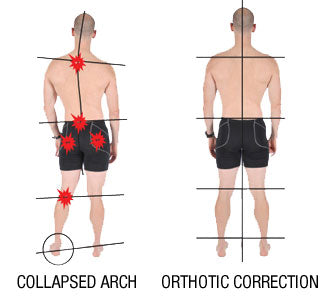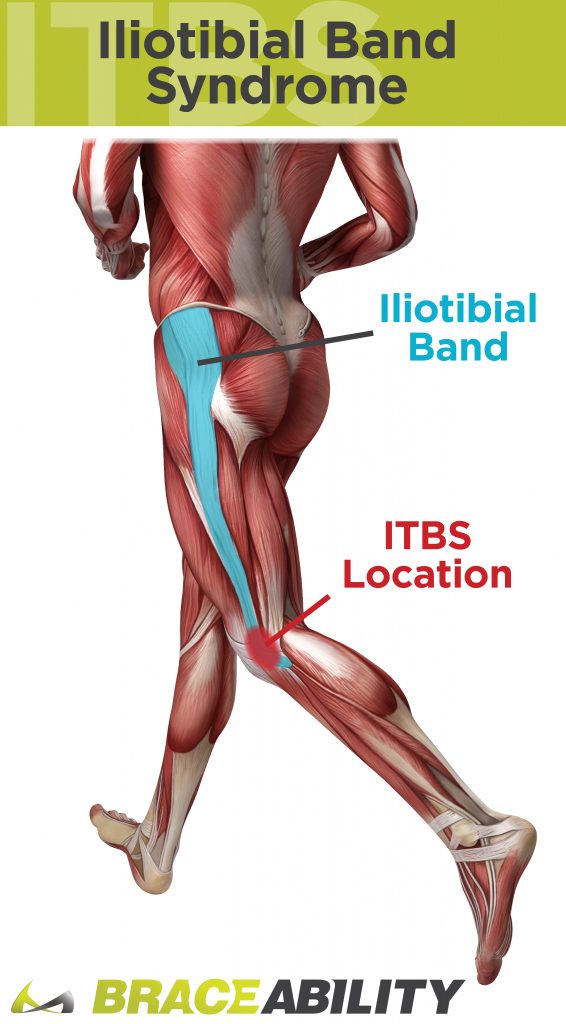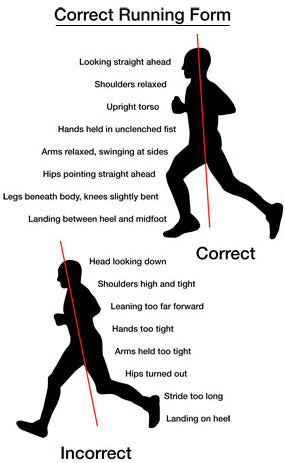Runner's Knee Pain: Causes, Symptoms, and How to Fix It
What Is Runners’ Knee?
Knee pain from running is so common of an occurrence that the term “runner’s knee” has become a commonplace way of describing a number of conditions that cause knee pain, and often pain around the front of the knee (AKA, patellofemoral pain). Frequently, runner's knee refers to patellofemoral pain syndrome, where the back of the kneecap comes in contact with the thigh bone, causing knee pain with running. But this term can apply to a number of running-related injuries.
The good news is there are a number of non-surgical ways to treat runner’s knee pain.
What Causes Knee Pain When Running?
There are a variety of knee injuries from running or conditions that may make the knee hurt after running or during the act. When and where such pain develops can be telling as to what is causing knee running pain.

Alignment issues can be either a direct or indirect cause of knee pain while running. Flat feet or overpronated feet (excessive inward rolling of the foot) can lead to knee pain while running or after running as this causes alignment issues with the kneecap. (Check out our arch support inserts.) Similarly, unbalanced, tight or weak leg muscles may cause alignment troubles and result in running knee pain.
Such problems can also increase one’s risk of a subluxated or a complete or partial kneecap dislocation, which can cause substantial runners knee pain.
Major increases in distance or pace can cause knee pain after running or during running. Overdoing it can strain or irritate the soft tissues of the legs and knee, causing knee pain after running or while one is running. Not surprisingly, new runners often experience knee pain.
Excessive stress on the knees can wear down the kneecap cartilage, causing conditions like chondromalacia or arthritis.
It is important not to ignore runners’ knee symptoms such as pain, swelling, stiffness, etc. If the knee hurts when running or after, this is the body’s warning signal that something is wrong. Ignoring a sore knee from running or running through knee pain is a sure way to do further damage and possibly cause permanent running knee problems, like arthritis. Many medical professionals recommend avoiding running with knee arthritis.
Runner’s Knee Symptoms
Symptoms of runners’ knee vary depending on the injury and the person. If one is experiencing pain below the kneecap after running he or she might be experiencing patellar knee tendonitis from running. At its onset, patellar tendonitis pain may be present only at the beginning of one’s workout, or one may experience pain in the knee after running. Ignoring this discomfort may lead to near constant pain in the knee from running.
Damage to the cartilage below the kneecap is another possible knee injury from running that causes anterior knee pain. When this occurs, it is known as either patellofemoral pain syndrome (PFPS) or chondromalacia. This condition causes knee pain around the kneecap and/or pain behind the kneecap. Heightened knee pain when running downhill, climbing stairs, squatting or sitting for an extended period may indicate one’s kneecap cartilage is breaking down or has eroded.
Outer knee pain when running (lateral knee pain) may indicate one’s iliotibial (IT) band at the outer part of the knee is irritated, especially if one is a long-distance runner. IT band syndrome (ITBS) is often a source of knee and hip pain from running long distances.

Sharp pain in the knee when running may be a sign of a meniscus tear. Whether one has experienced a medial or a lateral meniscus tear will determine if the individual experiences inner knee pain with running or outside knee pain when running, respectively.
Soft tissue injuries are the most common reasons for back of knee pain from running (posterior knee pain), though injuries to the popliteal muscle that is important to running downhill can also cause posterior knee pain with running. If one steps in a pothole or loses one’s balance on an uneven surface, twisting the knee, one might tear a ligament such as the anterior cruciate ligament (ACL) that stabilizes the knee. An ACL tear typically causes intense pain behind the knee or at the outside of the knee and swelling, instability and limited movement.
Regardless of what one thinks may be the culprit for knee problems linked to running, he or she should always seek a professional diagnosis regarding what exactly is causing the sore knee after running and how to cure runners’ knee. Runners’ knee recovery time will depend upon the knee problem and its severity as well as the patient’s age, health, etc.
How to Fix Runners’ Knee
Running and knee pain do not have to be permanently linked; there are a number of steps one can take to alleviate runner knee pain. However, just what helps will vary depending on runners’ knee causes and the person. The following are some general guidelines when it comes to how to heal runners’ knee. However, this is in no way intended as a substitute for professional advice.
Resting the knee and giving it a chance to heal are some of the first steps for runners’ knee recovery. Protecting the vulnerable knee is another priority when it comes to knee problems from running.
This might involve wearing knee braces or knee wraps for running. Such products provide lightweight support to the knee and protect against movements that might cause more damage.
Knee pads for running may be a good option for some, especially those involved in contact sports.
Some knee sleeves for running can also help with patellar tracking, similar to athletic bandages or Kinesio tape (kt tape) for runners’ knee. Such knee orthotics for runners’ knee are much simpler to apply than learning how to tape a knee for running.
Besides rest, healing runners’ knee may well involve elevating and icing the knee as well as applying compression. These steps can help bring down knee swelling after running. The latter also promotes blood flow and healing. A knee sleeve for running will apply beneficial compression. Some choose to wear such products as a way of preventing runners’ knee.
An even lighter weight option of applying compression might be wearing running knee socks. Such products have the added benefit of warming the calf.
Another way to cure runners’ knee is to engage in runners’ knee exercises to strengthen the muscles of the leg so that less stress is put on the kneecap. Knee strengthening exercises for runners can also help correct muscle imbalances or tracking problems that may be causes of knee pain in runners. Tight muscles can also cause a sore or stiff knee after running. Stretches for runners’ knee can help. Indeed, warming up properly and engaging in knee stretches for runners can help prevent an injury from occurring in the first place.

Cylinders of foam known as rollers can also help relieve knee pain. Foam rollers help runners knee as “rolling” the muscles that attach to the knees can help maintain flexibility and alignment of the joint. Find more foam roller exercises for the knee here.
Another good practice is to make sure to wear proper running shoes for knee pain. With today’s wide selection, one can even undergo tests to make sure one gets the best running shoes for one’s knee pain. The best running shoes for runners’ knee will support the foot, including the arch. For some, simply switching shoes is sufficient as a runners knee cure.
For more serious injuries like a ligament tear, extensive runner's knee rehab including time with a physical therapist may be needed and possibly surgery to relieve knee pain from running. As one gets back to running, he or she may need a functional post-op knee brace for added protection and support for running after knee surgery.
Preventing Runners’ Knee

Warming up is an important component of a workout if one wants to avoid knee soreness after running. Improving the strength and flexibility of one’s leg muscles is another important step for avoiding pain in the knee when running in the first place.
It is important for runners to gradually increase mileage to prevent knee pain while running. Runner’s World recommends stepping up one’s mileage, less than 10% per week. Knee pain after running long distances that the body is not used to is not surprising.
Another key when it comes to avoiding knee problems for runners is to wear proper gear. Most important is getting the best running shoes for one’s knee problems, meaning ones that are well suited for one’s arches and gait.
Being overweight or obese can take a major toll on one’s knees. For that reason, it is important to maintain or get to a healthy weight if one wishes to avoid running with knee pain. Long-term damage to the knee can cause arthritis or possibly even lead to knee replacement surgery. Medical professionals generally advise against high impact activities like running after knee replacement surgery.
And finally, using proper running form and being selective about one’s terrain is also important for avoiding knee pain with running. Running straight down a steep hill or on uneven ground increases one’s risk of knee pains from running.
Common Knee Injuries from Running
When most people think of running, they view it in the light of something that is beneficial for your body. While that is true in that it can improve your heart health, help with weight loss and provide a boost in mood or self-esteem, there is also a downside to running. Namely, the repetitive motions and impact of “pounding the pavement” can take a toll on the body.
For this reason, it is important to pay attention to any foot, hip or knee pain from running and to take steps to address any such pain. It is also important to engage in “safe practices,” if you will, relative to running. I will go into more detail on how to relieve knee pain from running and how to ward off future injuries momentarily. But first, I will detail a few common running knee injuries.
Runners’ Knee Pain
The term “runners’ knee” is a general term for knee pain associated with running. (This condition is similar to Jumper's Knee.) Typically, this includes knee pain while running and in some cases knee pain after running in the vicinity around or behind the patella (kneecap).
Runners’ knee, also known as patellofemoral pain syndrome, can be brought on by a number of things. For one, overuse can irritate the nerves of the knee and overstretch the tendons, resulting in running knee pain.
Besides knee pain, running injuries of the patellofemoral pain syndrome variety can also cause tenderness, cracking sensations or knee instability. There are a number of knee braces for runners that can help ease knee pain and provide support.
Misalignment of the bones can also cause knee pain when running as this can result in too much weight or force being put on areas of the body that are not equipped to handle it. This, in turn, increases one’s risk of damaging the knee joint.
Misaligned bones can be due to misshapen or ill-fitting bones in the knee joint, or an abnormally high or flat arch of the feet. Knees that bow out or bend it can also result in abnormal weight distribution on the bones that leads to runners’ knee injuries.
Runners’ knee is estimated to be up to two times more common in women than men, according to the British Journal of Sports Medicine. This is largely due to the greater angle between the thigh bone and the knee that results from the wider hips of the female sex. This puts more stress on the knees.
Muscular issues can also cause the patella to mistrack. Weak quadriceps muscles or especially tight leg muscles that cause one to run with some of the aforementioned atypical forms are associated with running and knee pain. BraceAbility offers knee braces specifically designed to improve the tracking of the patella.
Running can also cause cartilage of the knee to wear down. This can result in knee pain with running, often in the area just below the kneecap.
Outside Knee Pain: Running with ITBS
Another fairly common source of runner knee pain is iliotibial band syndrome (ITBS). This injury is especially common among distance runners and it typically causes lateral knee pain when running. ITBS is thought to be the most common source of outer knee pain from running. The pain in knee when running associated with ITBS typically fades quickly once one stops the activity.
So what causes ITBS? Well, the iliotibial band is a thick band of tissue that runs along the outside of the leg from the hip to the top of the shin bone. Its primary function is to control abduction of the thigh.
When one is running, the IT band slides back and forth over a bony structure known as the lateral femoral epicondyle (the bump in the thigh bone near the knee). Too much of this action can cause the band to become inflamed, resulting in painful friction on the lateral part of the knee as one is running.
There are a number of factors that can increase one’s likelihood of experiencing this type of runner knee pain, including major foot pronation (see “Pronation, Explained”), running in worn-out shoes, differing leg lengths, tight leg muscles or being bow-legged.
Inner Knee Pain: Running & Plica Syndrome
Plica syndrome is much harder to diagnose than the aforementioned conditions. The quick definition of plica syndrome is that this refers to irritation of the lining of the knee joint that often results in running knee problems. Plica refers to thin remnants from the fetal stages of one’s early developments that are located in the sleeves of the synovial folds; more specifically, these appear as an extension of the synovial capsule.
When the synovial capsule is irritated from activities such as running, plica thicken, making it more likely to get caught on the femur (thigh bone) or pinched between the femur and the patella. This typically causes medial knee pain with running, along with a catching, locking or a crackling sensation/sound of the knee.
Overuse, as well as tight hamstrings and/or weak quadriceps muscles, can increase one’s likelihood of developing plica syndrome.
Running Injuries: Knee Bursitis
The knee has 11 bursa or small lubricating sacks. Irritation of the bursa can also cause knee pain. One of the more common running injuries to the knee is pes anserine bursitis. This refers to irritation of the bursa located between the tibia (shin bone) and the three tendons of the hamstring muscle at the inside of the knee. This irritation can stem from overuse and friction, resulting in inside knee pain with running and other repetitive activities.
Again, tight hamstrings and being bowlegged can increase one’s risk of developing this injury, as can obesity or osteoarthritis. Suddenly increasing one’s distance or the number of hills in one’s run can also increase one’s risk of bursitis-related pain in the knee after running.
Bursitis knee pain from running typically develops gradually inside the knee and/or near the center of the shinbone a few inches below the knee joint. The intensity of the pain often increases with activity or climbing stairs.
Knee Pain Running Treatment
BraceAbility offers a wide selection of Knee Injury Treatments, including treatments for general knee pain and treatments for jumper's knee or runner's knee. You can likely infer a number of the knee pain treatment and preventative steps from the descriptions of the risk factors for developing runner’s knee pain. First, it is important not to “muscle through” knee pain. Pain is a red flag that something is wrong. Heed it and seek the help of a professional.
Most instances of knee pain and running can be remedied by conservative treatments. The first line of defense is often engaging in the steps of RICE—rest, ice, compression and elevation—possibly with the use of an over-the-counter anti-inflammatory medication. A doctor can recommend a number of knee injury stretches and exercises to strengthen and improve the flexibility of key leg muscles.
When one gets back to running, it is important to always stretch and warm-up before a run. The use of proper running shoes for knee pain avoidance is also important. This includes wearing shoes that are supportive and suited to your foot and gait.
Wearing an appropriate amount of clothing for the weather is also important for preventing sore or tight muscles. Use of a knee brace for runners or a runner's knee band may also provide some useful extra support and a boost in circulation that can promote healing as one eases back into training.
When in recovery mode from a knee injury, one should avoid hilly, uneven terrain. And when one does begin working hills back into a workout, this should be done gradually with attention to form. The same can be said for adding miles to one’s run. Watch this video on proper, safe and efficient running form:
Strength training and cross-training for more balanced strength throughout the body is also important for knee injury prevention.
Unfortunately, there are times when conservative methods are not effective. In such cases, more invasive methods such as injections or surgery may be needed to relieve knee pain from running.
View our related blog posts on this topic:
Patellar Tendonitis Treatment and Surgery






